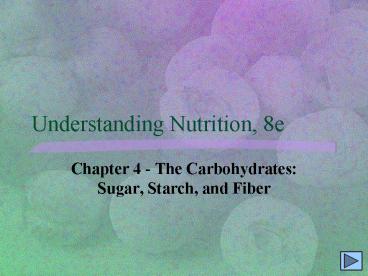Understanding Nutrition, 8e PowerPoint PPT Presentation
1 / 24
Title: Understanding Nutrition, 8e
1
Understanding Nutrition, 8e
- Chapter 4 - The Carbohydrates Sugar, Starch, and
Fiber
2
Atoms and Their Bonds
The four main types of atoms found in nutrients
are hydrogen (H), oxygen (O), nitrogen (N), and
carbon (C). Appendix B presents basic chemistry
terms and relationships.
3
Chemical Structure of Glucose
On paper, the structure of glucose has to be
drawn flat, but in nature the five carbons and
oxygen are roughly in a plane. The atoms attached
to the ring carbons extend above and below the
plane.
4
Simple Carbohydrates
The simple carbohydrates, glucose, fructose, and
galactose.
5
Simplified Diagrams of Glucose
(a) The carbons at the corners are not shown, and
the formula CH2OH stands for the structure in
Figure 4-2. (b) Now the single hydrogens are not
shown, but lines still extend upward or downward
from the ring to show where they belong. (c)
Another way to look at glucose is to notice that
its six carbon atoms are all connected. (d) In
this and other illustrations throughout this
book, glucose is represented as a blue hexagon.
6
Two Monosaccharides Glucose and Fructose
Can you see the similarities? If you learned the
rules in Figure 4-3, you will be able to see 6
carbons (numbered), 12 hydrogens (those shown
plus one at the end of each single line), and 6
oxygens in both these compounds. (c) Another way
to look at glucose is to notice that its six
carbon atoms are all connected. (d) In this and
other illustrations throughout this book, glucose
is represented as a blue hexagon.
7
Two Monosaccharides Glucose and Galactose
Notice the similarities and the difference. (c)
Another way to look at glucose is to notice that
its six carbon atoms are all connected. (d) In
this and other illustrations throughout this
book, glucose is represented as a blue hexagon.
8
Two Monosaccharides Form a Disaccharide
(a) An OH group from one glucose and an H atom
from another glucose combine to create a molecule
of H2O. (b) The two glucose molecules bond
together with a single O atom to form the
disaccharide maltose. (c) Another way to look at
glucose is to notice that its six carbon atoms
are all connected. (d) In this and other
illustrations throughout this book, glucose is
represented as a blue hexagon.
9
Hydrolysis of a Disaccharide
Hydrolysis occurs during digestion. (c) Another
way to look at glucose is to notice that its six
carbon atoms are all connected. (d) In this and
other illustrations throughout this book, glucose
is represented as a blue hexagon.
10
Glycogen and Starch Molecules Compared
Notice that the more highly branched the
structure, the greater the number of ends from
which glucose can be released. (These units would
have to be magnified millions of times to appear
at the size shown in this figure. For details of
the chemical structures, see Appendix C.) (a) A
glycogen molecule contains hundreds of glucose
units in long, highly branched chains. (b)A
starch molecule contains hundreds of glucose
molecules in either occasionally branched chains
(amylopectin) or unbranched chains (amylose).
11
The Carbohydrate Family
Simple carbohydrates (sugars).
12
Soluble Fibers
Fibers their solubilities, sources, and actions.
13
Insoluble Fibers
Fibers their solubilities, sources, and actions.
14
Absorption of Monosaccharides
(1) Monosaccharides, the end products of
carbohydrate digestion, enter the capillaries of
the intestinal villi. (2) Monosaccharides travel
to the liver via the portal vein. (3) In the
liver, galactose and fructose can be converted to
glucose.
15
Food Source of Energy
The carbohydrates of grains, vegetables, fruits,
and legumes supply most of the energy in a
healthful diet.
16
Maintaining Blood Glucose Homeostasis 1 of 5
When a person eats, blood glucose rises.
Animation of Gycogenesis
17
Maintaining Blood Glucose Homeostasis 2 of 5
High blood glucose stimulates the pancreas to
release insulin.
18
Maintaining Blood Glucose Homeostasis 3 of 5
Insulin stimulates the uptake of glucose into
cells and storage as glycogen in the liver and
muscle. Insulin also stimulates the conversion of
excess glucose into fat for storage.
19
Maintaining Blood Glucose Homeostasis 4 of 5
As the body's cells use glucose, blood levels
decline. Low blood glucose stimulates the
pancreas to release glucagon into the
bloodstream.
20
Maintaining Blood Glucose Homeostasis 5 of 5
Glucagon stimulates liver cells to break down
glycogen and release glucose into the blood.
Blood glucose begins to rise.
21
Food Sources of Starch and Fiber
Foods rich in starch and fiber offer many health
benefits.
22
Diverticula
Diverticula may develop anywhere along the GI
tract, but are most common in the colon.
23
Estimating Carbohydrates
Carbohydrate exchange.
24
Foods Containing Carbohydrates
Carbohydrate-containing foods appear in several
exchange lists starches, fruits, milks, "others"
such as desserts and snacks, and vegetables.
Sugars also contribute carbohydrate.
Exit

